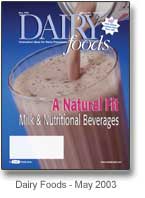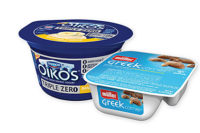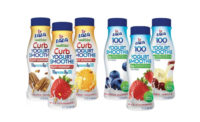
Every day we read about the rapidly growing global functional foods market. According to the Institute of Food Technologists, the food industry is expanding at 2-3% per year while the functional foods segment is growing at 10% per year. Currently, the global functional foods market is believed to be as high as $48 billion. Beverages, breads and cereals dominate this market.
The functional dairy category ranks a distant fifth. It is dominated by products that contain probiotic bacteria and those fortified with calcium and vitamins. These ingredients are considered to be relatively low cost and easiest to sell in the conservative U.S. dairy industry, which happens to be more regulated than the beverage industry.
The easiest way to position dairy products as functional is to add probiotic cultures. Probiotics and yogurt are a good synergistic fit and a true functional food success story. Many clinical studies have shown probiotic strains to contribute to improved intestinal health. Additionally, when Bifidobacteria are used to make yogurt, the resulting mild flavor imparted by both the bacterial metabolism and the higher yogurt pH are pleasing to many consumers. Bifidobacteria, Lactobacillus acidophilus, Lactobacillus casei and others are readily available in frozen and freeze-dried form for easy addition to yogurt, fluid milk and other dairy products.
To continually build a functional image, the dairy industry must expand. However, consumers may not interpret the addition of more expensive, less traditional ingredients to dairy foods as "value." This excludes dairy companies and consumers from access to some of the more unique and interesting functional ingredients. Yet in the meantime, dairy beverages continue to lose ground to soft drinks despite dairy's healthful image.
U.S. consumers say that they are interested in healthful foods; however, health ranked behind flavor, texture, price, brand and fat content as the most important food purchasing attributes. This is in stark contrast with some of the top attributes consumers expect from dietary supplements such as improved well being, stress reduction, cholesterol reduction and treatment of osteoporosis, arthritis, fatigue and depression. Clearly consumers are not viewing food as medicine.
The success of single-serve packaging has demonstrated that consumers are willing to pay for portability and convenience. It's easy to envision a drinkable functional yogurt marketed as a portable meal replacement. Drinkable yogurt commands a higher selling price vs. cup yogurt so it could absorb the cost of added functional ingredients. In this form, yogurt sheds the diet image and becomes powerful "food as fuel."
A significant hurdle for dairy product manufacturers is the lack of regulatory approval for some functional ingredients. Another hurdle is the negative press received by some ingredients. However, several interesting ingredients such as lecithin/choline for liver health and hydrolyzed gelatin for joint health are both safe and approved for food use. In addition, FDA has approved labeling foods to reflect a high content of choline, which has been declared an essential nutrient for normal liver function. These relatively low-cost ingredients offer untapped opportunities for dairy product manufacturers to differentiate their offerings.
In summary, the platform for dairy product manufacturers is to help consumers make the transition to functional foods by providing convenient, great-tasting foods that have substantiated, desirable, easily communicated and on-trend health benefits that require little if any behavioral change.
It's time for the dairy industry to become more functional. Continual education of dairy consumers will be required and it will be challenging to get these conservative consumers to take risks. But the bigger risk for the dairy industry is to sit idle and miss this growth opportunity.

